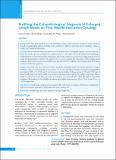Please use this identifier to cite or link to this item:
https://hdl.handle.net/20.500.14356/1195| Title: | Profiling the Cytopathological Diagnosis of Enlarged Lymph Nodes on Fine Needle Aspiration Cytology |
| Authors: | Shrestha, Sujan Khadka, Dinesh Thapa, Anuja Bhandari Shrestha, Kshitiz |
| Citation: | ShresthaS., KhadkaD., Bhandari ThapaA., & ShresthaK. (2022). Profiling the Cytopathological Diagnosis of Enlarged Lymph Nodes on Fine Needle Aspiration Cytology. Journal of Nepal Health Research Council, 19(04), 712-716. https://doi.org/10.33314/jnhrc.v19i04.3797 |
| Issue Date: | 2021 |
| Publisher: | Nepal Health Research Council |
| Article Type: | Original Article |
| Keywords: | Cytopathology fine needle aspiration cytology lymph node |
| Series/Report no.: | Oct-Dec, 2021;3797 |
| Abstract: | Abstract Background: This study aimed to assess the distribution of fine-needle-aspiration-cytology or biopsy findings through cytopathological patterns of lymph nodes aspirations in different age groups of the population visiting a tertiary level hospital in Kathmandu. Methods: The retrospective study was conducted on the database of the 226 lymphadenopathy cases that underwent biopsy fine needle aspiration cytology from 1 January 2016 to 31 December 2019 at the Department of pathology of Helping Hand’s Community Hospital, Kathmandu. A descriptive analysis was performed yielding proportions and counts for the quantitative variables. Chi-squared test was used to compare the proportions. Point estimates and confidence intervals for measures of association were assessed with 95% confidence interval and p-value ?0.05 was considered statistically significant. Results: The 20-40 years were the most common age group undergoing biopsy fone needle aspiration cytology procedures. Males recorded majority of cases (68%, 153 of 226). The highest incidence of Reactive lymphadenitis was obtained (50%, 113 of 226) and it was the most common findings in the age group of <20 and 40-60 years. The Cervical lymph node (86%) was the most common anatomical location followed by axillary lymph nodes (8%). Squamous cell carcinoma and Adenocarcinoma accounted for more than half (53%, 20 of 38) of all the diagnosed malignancy. The incidence of Non-Hodgkin lymphoma and Hodgkin lymphoma were 8% (n = 3 of 38) and 5% (n = 2 of 38) respectively. Conclusions: Lymph node enlargement is associated with a wide range of etiologies with Reactive lymphadenitis as the most common cause and cervical lymph node as the common site. Keywords: Cytopathology; fine needle aspiration cytology; lymph node. |
| Description: | Original Article |
| URI: | http://103.69.126.140:8080/handle/20.500.14356/1195 |
| ISSN: | Print ISSN: 1727-5482; Online ISSN: 1999-6217 |
| Appears in Collections: | Vol. 19 No. 04 (2021): Vol 19 No 4 Issue 53 Oct-Dec 2021 |
Files in This Item:
| File | Description | Size | Format | |
|---|---|---|---|---|
| 3797-Manuscript-26800-2-10-20220313.pdf | Fulltext Download | 266.48 kB | Adobe PDF |  View/Open |
Items in DSpace are protected by copyright, with all rights reserved, unless otherwise indicated.
